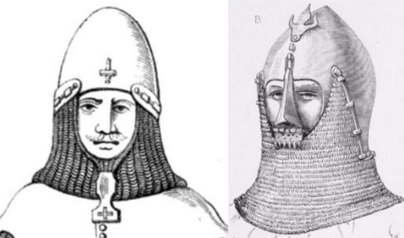|
1/18/2020 1 Comment The Bascinet in the 14th centuryIntroduction: the bascinet
Bascinet Origin: The CervelliereThe origin of the bascinet is the hemispherical steel cap called Cervelliere. It was introduced in the late 12th century to provide protection from the tophead to the forehead of the European soldiers. Soldiers either wore it alone or under or over a mail coif. In the 13th century, it became a common practice for knight to wear a Cervelliere under a great helm. Overtime, the Cervelliere extended to the neck of the wearer, becoming the first bascinet. 1st Development: the Extension to the neckWhen the Cervelliere began to extend downward to the neck of the wearer, it became known as the bascinet. The earliest surviving bascinet is currently located in the Metropolitan Museum of Art in New York (the MET). It was created around the first quarter of the 14th century. Knight stopped wearing this helmet underneath the mail coif. Instead, he wore it over the mail coif as demonstrated in the effigy of Sir Robert du Bois. The early bascinet did not have an aventail attached or a visor to protect the wearer's face in comparison to later bascinets. It is interesting to note that a series of small holes in the lower part of the 1325 bascinet were not meant to be attached with an aventail (Camail). They are places where the bascinet and the padded lining joint together by sewing.
2nd development: Aventails
3rd Development: Face protection
1. The Bretache Bascinet: The bretache is a nasal guard that attaches to the bascinet. Early bretache was made from riveted mail that connects to a aventail. It evolved to a piece of plate armor as in the illustration of from the monument of Ulrich Land Schaden. Some European knights wore a greathelm over this type of bascinet. 2. Visored Bascinet: The most advanced bascinet type in 14th century was the hounskull (pig-faced) bascinet. Many historical bascinets of this type were well preserved. There were two types of visored bascinet depending on how the visor attaches to the helmet. In the Klappvisor, visor was hinged at a single pivot in the center of the brow of the helmet skull. The double-pivot type the visor was attached to two pivots – one on each side of the helmet. Other than that, there were no significant differences between them. The visor was pointy in the nose area, so it could deflect incoming projectiles and weapon blows to the wearer's face. When in hand-to-hand combat, the visor could be lifted or even detached to provide the knight extra needed vision. It was because of the introduction of the visor, the practice of wearing a great helm over the bascinet was ceased to exist. Knights favored the light-weighted hounskull bascinet in battle while the great helm and its successors stayed in jousting tournaments. Successors of the BascinetThe bascinet continued its development in the next centuries into the great bascinet and eventually be replaced by the more advanced armets. The discussion about the great bascinet and armet will be discussed in future posts.
1 Comment
|
Viet LeThis section is dedicate to the understanding of armor. |
Proudly powered by Weebly




















